Kaiser class Battleships (1911)
 Germany – Kaiser, Friedrich der Grosse, Kaiserin, König Albert, Prinzregent Luitpold
Germany – Kaiser, Friedrich der Grosse, Kaiserin, König Albert, Prinzregent Luitpold
Kaiser class: A brave leap forward
The second “Kaiser class” (the first dated back from 1899) was designed as an attempt to use turbine engines and superfiring turrets. However, they stuck with the 12-in caliber of the last class, already inferior to the British 14-in series dreadnoughts, Orion, King Georges V and Iron Duke class. Five were built which made up for numbers while the German Imperial Navy was late in the up-gunning process. The one, SMS König Albert was completed in July 1913, just one year prior to WW1, while at the same time was completed HMS Audacious, 8th of the “super-dreadnoughts”, just one month before the launch of HMS Queen Elisabeth first, of British “super battleships” armed with 15-in guns. The König class had an axial layout, loosing one turret without improvement in speed or protection, while completion was rushed in the early months of WW1. The development of a new artillery, a very long process, was postponed, but catch up with the 16-in caliber of the Bayern class. During their carrer they were found in action at the Raid on Scarborough, Hartlepool and Whitby, the Bombardment of Yarmouth and Lowestoft, of course the Battle of Jutland, and Operation Albion in the Baltic. They all survived the war to be scuttled in Scotland in 1919.
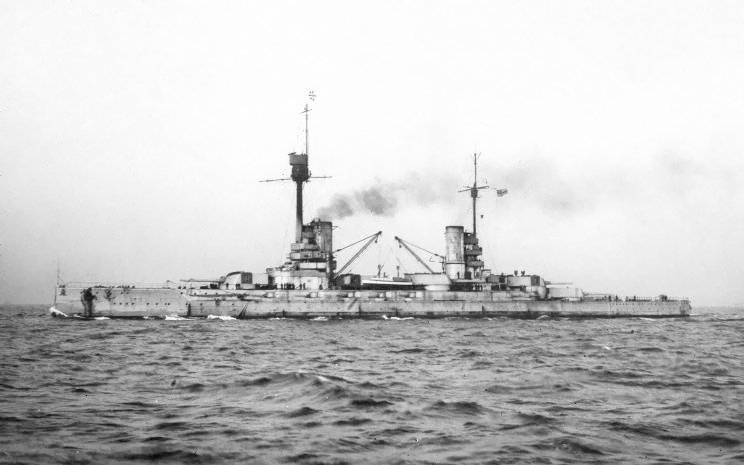
SMS Friedrich der Grosse
Development of the Kaiser class
The Kaiser-class were ordered under the same Second Naval Law, same as for the earlier Helgoland-class battleships. This precised an active life down from 25 to 20 years, a “programmed obsolescence” to push new constructions. The Kaisers were in short, part of the serie planned to replace the six Siegfried-class and Odin-class coastal battleships, while their followers the König, were to replace the Brandenburg class, of which two were sold to the Ottoman Empire meanwhile. Compared to the Helgoland class, they seemed a step back, with just five turrets like the HMS Dreadnought, but one less than the Helgoland (six). This was the cost for a better arc of fire, the broadside turrets being placed in échelon in order to be pointed in the interior of the ship (for the opposite side turret) and having a full broadside, albeit, with obvious limitations because of the superstructures. The other bold step of the design was the superfiring turrets aft, for the first time. The one less turret had other advantages, as this simplified protection and required less crew and ammunitions.
To compare at that time, the Blücher was basically a repeat of the Nassau/Helgoland configuration, while the next iteration, SMS Von der Tann, the first true German battlecruisers pioneered the échelon concept for the Kaiser class, with one less turret, started in 1907, but moreover the Moltke class battlecruisers, which had an extra turret aft, also superimposed. The latter were started in 1909 and launched in 1910-11, several months before the Kaiser. There was no sufficient gap between the two classes for one to be clearly blueprints for the others. For both the Moltke and Kaiser, choosing a twin superfiring turret aft configuration was not too risky given the examples of other ships (like the USN South Carolina class). They were completed in 1910 and therefore there was no active service return either. This choice was a bit of “leap of faith” from German engineers, with reasonably low risk.
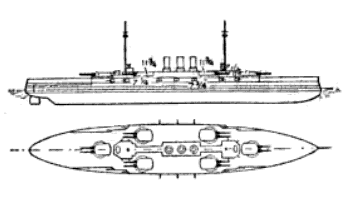
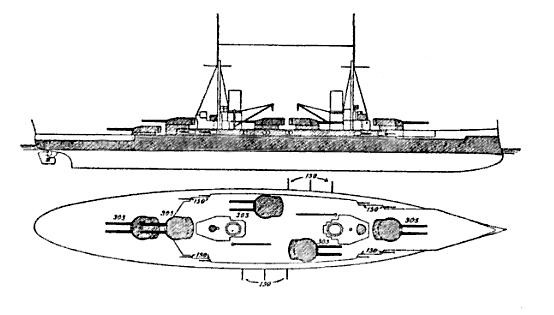
Helgoland and Kaiser class diagrams to compare (not to scale).
For the rest, the Kaiser class had a completely different profile, as funnels were truncated in two funnels very far apart in order to clear the two amidship turrets, and the bridge superstructures, masts, projectors all massed together. These two “islands” therefore looked cramped, but at the time, superstrctures were kept minimal.
Design of the kaiser class

Brassey’s class diagram
The Kaiser class battleships measured 171.8 m, 172.4 m (565 ft 7 in) long overall, so much longer than the Helgoland for only 50 cm more beame, giving them a slightly better ratio and top speed. Beam was 29 m (95 ft 2 in) for larger draft of 8.8-9.1 m (29 ft 10 in). Displacement was 2,000 tonnes above, at 24,724 metric tons as designed, 27,000 t fully loaded, versus 24,700 for the previous Helgoland class. This was bordering to the 30,000 tonnes limit, giving some thoughts as to keep the draught minimal for Baltic operations. However their core assignation was the North Sea. They had a double bottom making 88% of the hull’s length over 17 watertight compartments, slightly improving the ASW protection compared to the Helgoland class, which was the same but on 85% of the hull. Respective crews were also about the same, the Kaiser having 1084 on board versus 1093 on the Kaiser, but more as squadron flagships.
Starting their career in 1912-13, these capital ships showed good seakeeping, but suffered important speed losses in heavy weather. They were both responsive to commands but suffered from severe torque at a hard rudder, with structural suffering. Hard over, and they would loss up to 66% speed while heeling to 8 degrees. Their transverse metacentric height was however good at 2.59 m (8.5 ft) and they were good, stable firing platforms when not turning. The powerplant was much more modern, traduced by a gain of 0.5 knots.
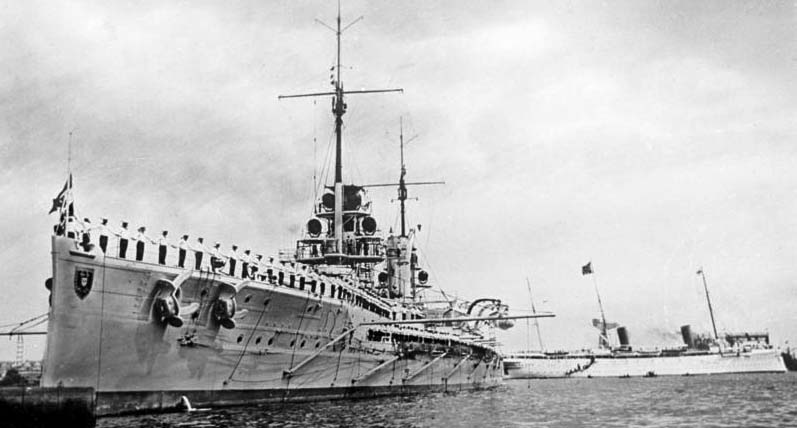
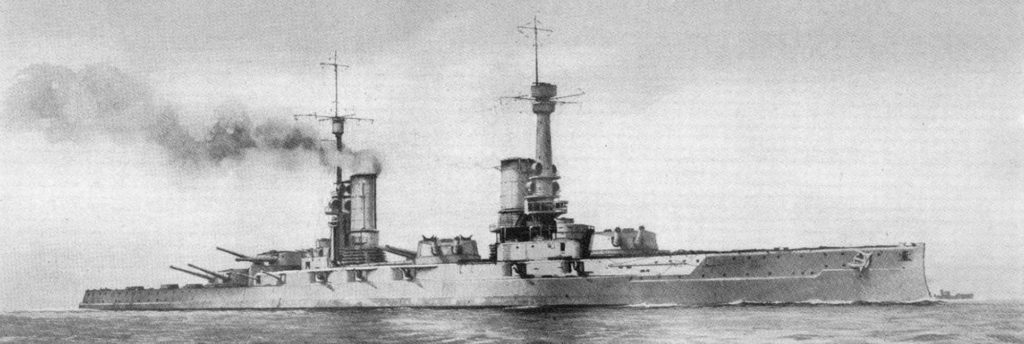
Recoignition drawing of the Kaiser class – The thick military mast was never mounted in reality
Powerplant
Germany was slow to adopt turbines for the propulsion of its battleships. The British already with the Dreadnought adopted this system in 1906, but it would wait until the third generation dreadnoughts for their adoption. The most obvious reasons were the engineering needed for such large steam turbines and the need to rush battleships production with trusted solutions, and cost. Indeed, Parsons held a monopoly on steam turbines, requiring 1 million gold mark of royalty for every turbine engine installed. Hence the choice of the same machinery for the Nassau and Helgoland, the second being scaled up version of the first with 12-in guns. The difference in output and speed was not that great in the end.
The Helgoland class relied on 3 shaft mated on 4-cylinder vertical triple expansion steam engines located in three separate rooms in case one was flooded. Output was 27,617 ihp (20,594 kW).
Development of German turbines took years indeed. Different manufacturers were given the task by Reichsmarineamt of finding an alternative to Parsons turbines, and in the end only the AEG-Curtis and Schichau turbines models were accepted. They were tried on the Friedrich der Grosse and König Albert while the two first were equipped with Parsons turbines nevertheless, in the idea they would be trialled and compared, and also reverse-engineered if needed.
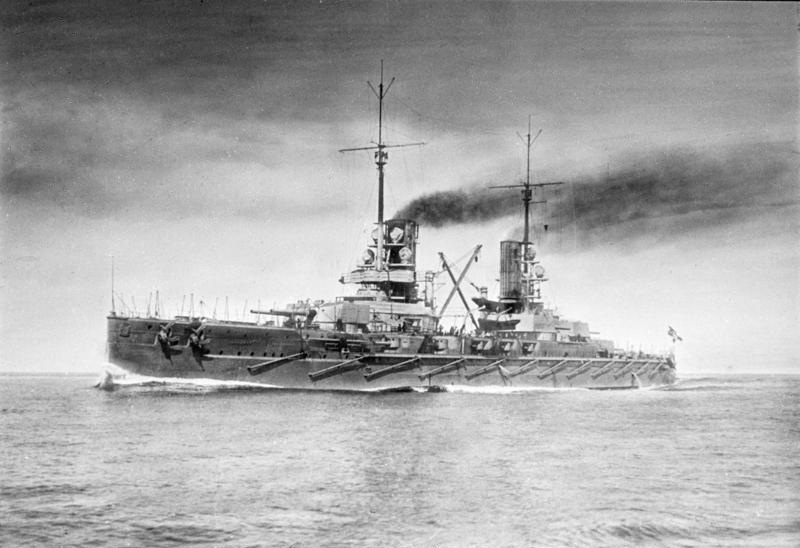
SMS Prinzregent Luitpold
The general disposition was about the same as in the previous class: Three shafts, three separate machinery rooms including a single steam turbine group and associated boilers. However they were two rudders, and the shafts spinned three-bladed screws, 3.75 m in diameter.
SMS Prinzregent Luitpold was given two sets of Parsons turbines for the outer shafts and it was planned to give them a single 12,000 bhp Germania 6-cylinder 2-stroke diesel engine in the center, but it not ready at the time the machinery compartment construction was nearly complete, and the yard could not wait. Therefore this battleship was the only one fitted with only two shafts and no central compartment. On trials this discrepancy made her one half knot slower than the others.
She also diverged by having 14 Schulz-Thornycroft water-tube boilers. Also this peculiar battleship had a reduced coal bunkerage: 3,200 metric tons, but also a provision for 400 tons of oil for the diesel engine that was never fitted. The latter would have given and extra 2,000 nautical miles at 12 knots by itself.
Apart Prinzregent Luitpold, all battleships of this class had 16 boilers, which will be upgraded with hollow grates, fitted between 1916 and 1917. Total output was 55.187 PS (40.590 kW), way above the Helgoland class, enough for a top speed of 23,4 kn (43 km/h) and more on trials. These battleships carried 3,600 metric tons of coal. This was enough for a range of 7,900 nautical miles (14,600 km; 9,100 mi) at 12 knots. At last, electrical power was provided by four double turbo-generators, and two diesel generators producing a total output of 1,800 kilowatts/225 volts.
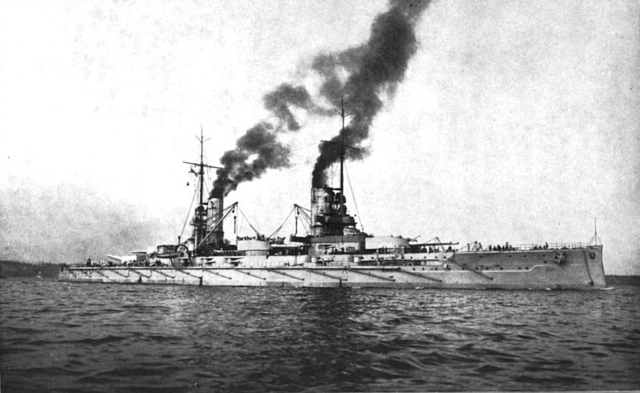
SMS Kaiser in 1912
Protection
Whereas the Helgoland used the Krupp cemented armor and layout used on the preceding Nassau-class ships, the Kaiser class used a somewhat different scheme, due to the location of turrets, but the same Krupp Cemented Armor and thickness figures about the same. It was ranging from 120–350 mm for the belt, to 60–100 mm for the decks, 40 mm for the torpedo bulkheads, 110–300 mm for the turrets, 170 mm for the casemate, and the conning towers were protected by walls ranging from 150–400 mm forward and 50–200 mm aft.
In detail, the armored belt, which was 13.8 in or 35 cm thick protected the central citadel, and tapered down to 7.1 in or 18 cm forward, 4.7 in or 18 cm aft, behind it there was a torpedo bulkhead, 4 cm or 1.6 in thick. The forward conning tower had a 15 cm (5.9 in) thick roof and it had 35 cm walls. Above it was mounted a reduced gunnery control tower with curved a face protected by 15.7 in or 40 cm thick plating.
The aft conning tower was lighter, with 20 cm or 7.9 in walls, and 5 cm or 2 in on its roof. The main turrets had 30 cm of sloped armor on the front and sides down to 22 cm or 8.7 in on their roof. The secondary battery was protected by 8 cm 3.1 in shields plating on their mounts, and their barbettes were 17 cm or 6.7 in thick.
Armament of the Kaiser class dreadnoughts
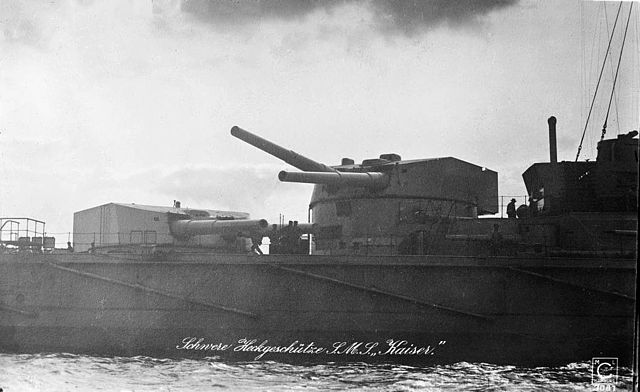
The novelty of the Kaiser’s design: Superfiring turrets aft.
Main guns: Ten (5×2) 30.5 cm or 12 in SK L/50 guns, in twin turrets, fore, en echelon amidships, and a superfiring pair aft. The ammo supply grand total was 860 shells, the equivalent of 86 rounds per gun. Shells weighted 894 lb (406 kg), muzzle velocity of the guns was 854 meters per second (2,805 feet per second).
Mountings were of the new Drh LC/1909 model very similar to the older LC/1908 mount of the Helgoland-class, and modified for a depression to −8 degrees elevation of 13.5 degrees, allowing a range up to 16,299 m (17,825 yd). Howeve these mountings were later modified for a lower depression at −5.5 but better elevation of 16 degrees and extended max range of 20,400 m (22,300 yd).
Secondary guns:: The ship’s mid-range relied on a battery of fourteen 15 cm (5.9 in) SK L/45 QF guns in casemates. TAmmo supply consisted of 136 99.9 lb (45.3 kg) shells, 2240 total for the ship. Muzzle velocity was 835 m/s (2,740 ft/s) and range was 13,500 m (14,800 yd). After modifications in 1915 (mountings, see above) the range became 16,800 m (18,400 yd), better than the Helgoland. T
Tertiary Battery: It comprised eight 8.8 cm (3.5 in) SK L/45 guns place on the superstructure for anti-torpedo warfare. They were replaced by four 8.8 cm L/45 Flak guns (AA angle), and two were later removed.
Torpedoes: As usual for the time the Kaiser-class ships were given five 50 cm (19.7 in) submerged torpedo tubes in a “T” arrangement, one in the bow, and two on each broadside.
The Kaiser class dreadnoughts in action
Of the five ships, one, SMS Kaider, was built at Kaiserliche Werft, Kiel, and the others at AG Vulcan, Hamburg (Friedrich der Grosse), Howaldtswerke, Kiel (Kaiserin), Germaniawerft, Kiel (Prinzregent Luitpold) and Schichau-Werke, Danzig (König Albert). They were completed and commissioned between the summer of 1912 and the summer 1913, one year before the war, and therefore the crews had some experience already when the war broke out.
During this pre-war period, two ships, Kaiser and König Albert, made a training cruise and goodwill tour to South America and South Africa. There was a part of power projection, but also an attempt to test the new Parsons turbine engines on long-range, like a serie long additional trials. Both ships returned home in their North Sea base. From then on, with the other battleships they formed a division of the Hochseeflotte and stayed relatively inactive, but for exercises.
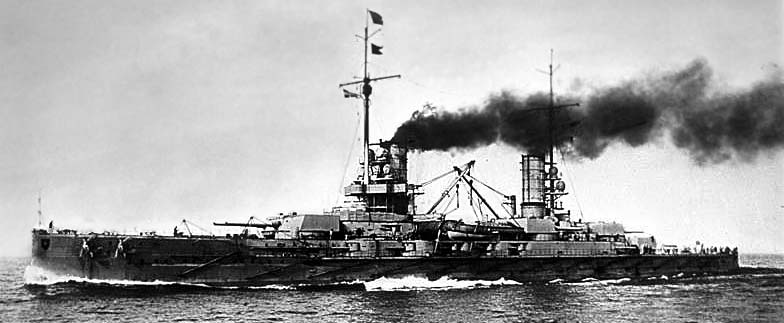
Raid on Scarborough, Hartlepool and Whitby (1914)
The first major operation where the Kaiser-class ships had a chance to fire their main battery in anger was the raid on the three British coastal cities on 15–16 December 1914. The idea was to provoke the British with fast ships that could have later drawn elements of the Royal Navy on the bulk of the German fleet and seek for a battle o positive terms for the Hochseeflotte.
The raid was led by battlecruisers of Franz von Hipper’s I Scouting Group and this advanced force was backed by the Nassau, Helgoland, and König classes, nine battleships, which departed later as a distant support. The High Seas Fleet (Friedrich von Ingenohl) took up a station in the center of the North Sea for this plan to work, 130 miles east of Scarborough.
However, the German high command was not aware that the Royal Navy was now in possession of the German code books (captured on SMS Magdeburg) and could decipher messages about an ongoing operation, although without details about where the Germans would strike. David Beatty’s 1st Battlecruiser Squadron and the 2nd Battle Squadron, cruisers and destroyers were dispatched to intercept the coming German battlecruisers. Soon Beatty’s task force clashed with the entire High Seas Fleet and at 6:20, the British destroyer screen came into close contact with the German advanced screen, and the torpedo boat V155.
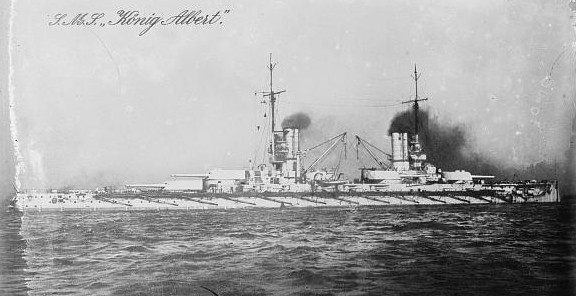
SMS König Albert
A two-hours battle followed, confused, in which British destroyers clashed with German light cruisers and destroyer screen, sometimes at very close range. At some point, at last, the Kaiser-class battleships ended at 10 miles from the 6 British dreadnoughts of the 2nd Battle Squadron, and came at firing range in the darkness.
At no point both admirals knew the composition of the opposing fleet. However Admiral Ingenohl had strict orders from the Kaiser’s to not risk his battlefleet without his express approval. Believing he faced the entire Grand Fleet he decided to break away 10 minutes after the first contact, taking a south-east course. At 6:42 he turned away but for about 40 minutes, both fleets stayed on a parallel course, still exchanging fire in the falling darkness. At 7:20, Ingenohl finally ordered another turn to port, reaching home waters. The battleships did not fired apparently. The raid was later resented harshly in British public opinion and became a rallying cry against Germany. On the German side, the fleet was preserved but no significant gain was made. Later, dissatisified with the results of the initial operation, Von Ingenohl was replaced by Von Pohl by the Kaiser.
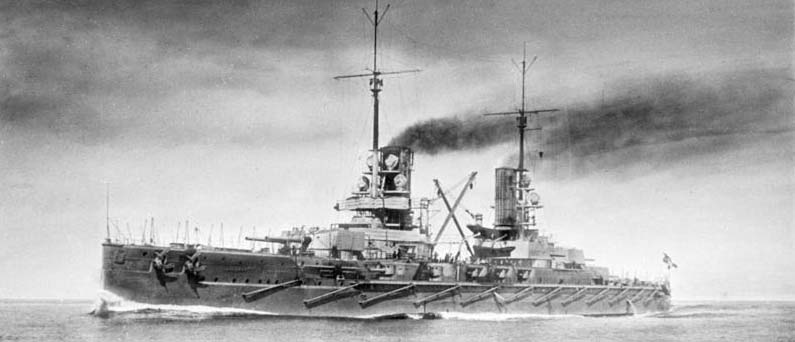
SMS Prinzregent Luitpold
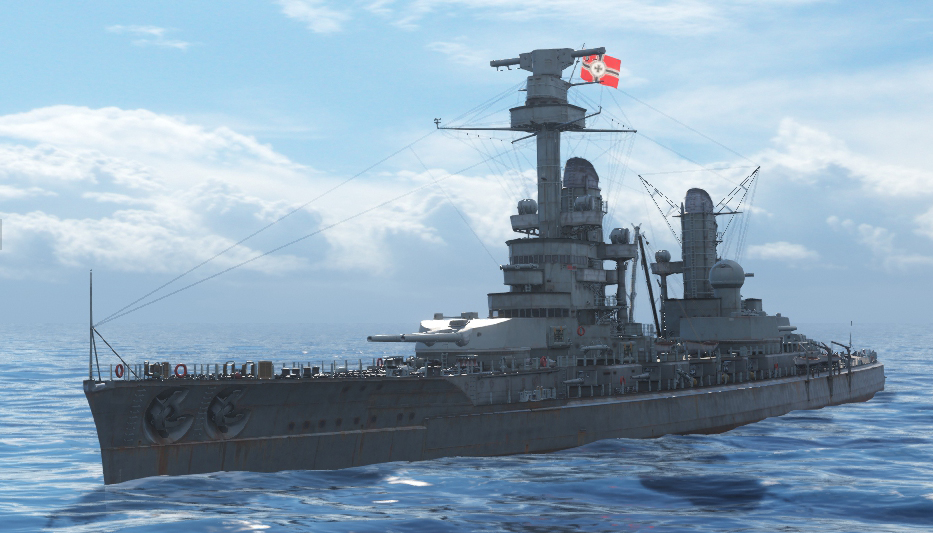
wow’s What-if of the Kaiser class if modernized in the 1930s for the Kriegsmarine
Operations in 1915
Admiral von Pohl tried a serie of fleet sweeps in 1915 in which the Kaiser class battleships took part. The first one happened on 29–30 March, the fleet sailing north of Terschelling and back without a chash. On 17–18 April, the Kaiser class took part in the covering at a distance of a mining operation, led by II Scouting Group.
On 21–22 April, the Hochseeflotte sailed to the Dogger Bank, but failed to meet the British but on 15 May, König Albert had a bushing which came loose in the ship’s starboard turbine. Decision was taken to turn the engine off and even decouple it. Forrtunately due to the ship’s design, the center and port side shafts were capable of making the ship sailing at 18 knots (33 km/h; 21 mph). On 29–30 May, another sweep in the North Sea happened, perturbed by the bad weather, which condicted Von Pohl eventually to cancel the operation, about 50 nmi (93 km; 58 mi) off Schiermonnikoog.
Until 10 August the fleet stayed inactive but made a quick sortie to Helgoland, covering the auxiliary cruiser Möwe returning from long range mission. A month later on 11–12 September, the fleet covered another mine-laying operation off the Swarte Bank, and the last operation of the year on 23–24 October, was an advance in the direction of Horns Reef. The fleet crossed no valuable target and returned home, staying for long months of inactivity, for the winter season.
On 11 January 1916, Admiral Reinhard Scheer replaced the ailing von Pohl suffering from liver cancer. He proposed a more aggressive plans in order to meet more decisively the Grand Fleet; His plan was approved by the Kaiser in February 1916 and setup patterns for operations this year. On 5–7 March, Scheer’s frist operation was in the region of the Hoofden but the force met no opposition. On 25–26 March, Scheer raided Tondern, but again met no enemy ship. On 21–22 April, the sweep was at the Horns Reef, again without result. On 24 April, the I Scouting Group’s battlecruisers raided the English coast at last, aiming at shelling Yarmouth and Lowestoft.
Raid on Yarmouth and Lowestoft (April 1916)
In this situation the scenario was repeated and one again the same battleship force was sent later to take position in the middle of the norht sea; while the German battlecruiser force in I Scouting Group made an advance sweep in order to shell Yarmouth and Lowestoft. They departed at 10:55 on 24 April 1916, from the Jade, whereas the battlefleet followed at 13:40. It should be added that Seydlitz struck a mine while en route to the target, and had to withdraw, while the rest reached Lowestoft and shelled the city, then turned to Yarmouth, when they encountered the British cruisers of the Harwich Force.
The latter withdrawn after a short skirmish, whereas British submarines were reported and the German battlecruiser force withdrawn in turn. Meanwhile, Admiral Reinhard Scheer, at the head of the battlefleet, including the Kaiser class, received the message the Grand Fleet has just steamed southwards, and he decided to withdrawn his force. Once again, the Kaiser class did not fire a shot.
After the raid on Yarmouth however, III Squadron battleships shown condensers problems. Tubing needed to be replaced in main condensers, and for this, the machinery interior needed to be acessessed, which imposed extensive dockyard work. König Albert went into drydock in the Imperial Dockyard in Wilhelmshaven on 29 May just two days before the Battle of Jutland that she missed. Machinery work was completed on 15 June.
Battle of Jutland (May 1916)
The Kaiser class battleships stayed mostly inactive during the period between April and May 1916. The class was amputated from König Albert, but all four battleship would participate nevertheless to the greatest naval battle of the first world war, and arguably largest of the century (Leyte battle in 1944 was partly an air battle). Jutland was the largest of all “classic” surface gunnery naval battle.
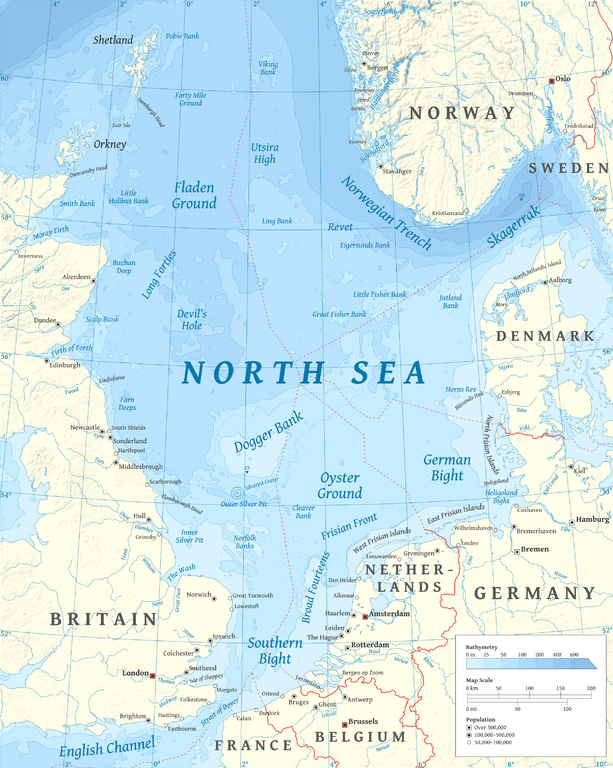
The fleet sortie involving the four Kaiser class dreadnoughts started as usual, the battleship force supposed to stay behind as a cover force. On 31 May 1916 Scheer’s plan was still to draw a portion of the Grand Fleet out to destroy it by any means necessary. The whole battleship force, Kaiser, Kaiserin, Prinzregent Luitpold, and Friedrich der Grosse were at the center of this force, and Scheer’s flagship was Friedrich der Grosse. This force made up the VI Division, III Battle Squadron. This one was of the three battleship units deployed at that time, with the more modern and fast König-class battleships (V Division) opened the line. The Kaiser class, III Battle Squadron, were behind the vanguard of the fleet. Astern were the Helgoland and Nassau-class battleships (I Battle Squadron) and there was a trailing rear guard with the older Deutschland-class pre-dreadnoughts (II Battle Squadron).
Just before 16:00 CET, I Scouting Group’s battlecruisers stumbled upon the British 1st Battlecruiser Squadron (David Beatty). A fierce artillery duel started, seing the destruction of HMS Indefatigable shortly after 17:00. HMS Queen Mary followed soon after. As planned, the German battlecruisers steamed south, luring the British ships towards the arriving High Seas Fleet.
At 17:30, SMS König, the lead battleship spotted the German Ist Scouting Group with Beatty’s 1st Battlecruiser Squadron hard on its heels. The battlecruisers then veered to starboard and the British to port. So at 17:45, Scheer ordered to turn port, bringing his ships closer to Beatty, and soon after commenced firing. In this gunnery fest, the Kaiser-class vessels to the exception of SMS Prinzregent Luitpold, still lacked the range to engage the British battlecruisers.
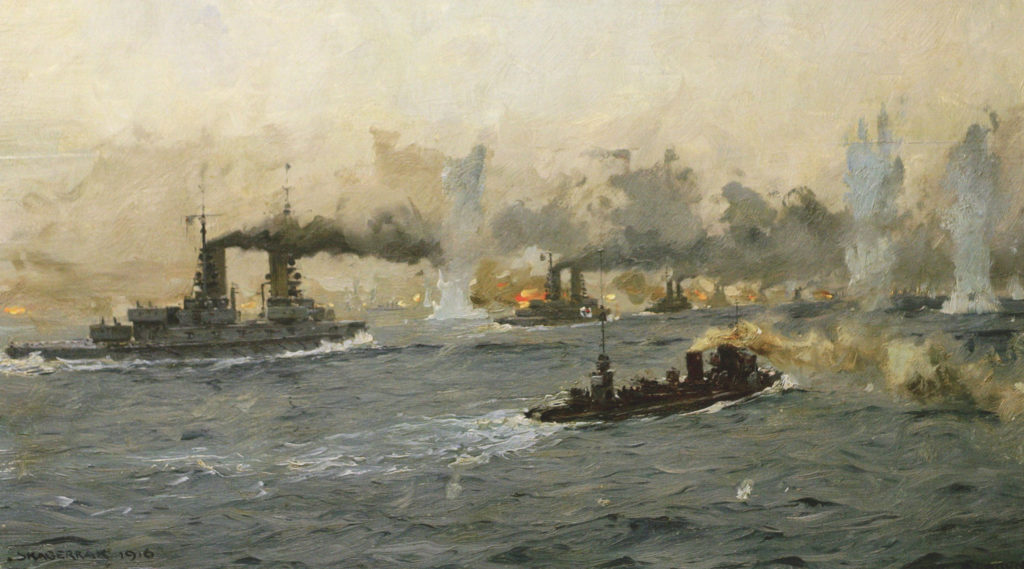
SMS Prinzregent Luitpold however made it close enough to fire eight salvos at 22,300–21,300 yards (20,400–19,500 m), but the range widened again. SMS Kaiser and Friedrich der Grosse meanwhile with the II Battle Squadron came in range of the British 2nd Light Cruiser Squadron but the massive broadside from the ten battleships came in a close area, so far as to make accurate spotting difficult. It ceased after a few salvos.
At around 19:00, SMS Wiesbaden previously disabled, came under attack from British light forces and Scheer ordered another turn to cover her and take her under under tow but barely 5 minutes later HMS Defence and Warrior fell on the crippled Wiesbaden. 10 min. later when Hipper’s battlecruisers and the III Battle Squadron arrived, fire fell on the British ships at 8,000 yards. Both the four Kaiser and the three König-class battleships rained down fire on the two armoured cruisers. One shell fell in HMS Defence’s magazines, causing a massive explosion. She broke in two and rapidly sank. HMS Warrior was herself badly damaged, burning from both ends, but managed veer northward, towards the arriving Queen Elizabeth-class battleships (5th Battle Squadron) under cover of her own smoke.
Then this was big time, of heavy gunnery: HMS Warspite nearly collided with HMS Valiant, turning to starboard and the whole German battleline erupted. A shell from SMS Kaiser hit Warspite’s steering gear and the ship was soon dead in the war, forced to turn in circles. Friedrich der Grosse, König, two Nassau and three Helgoland class ships then concentrated their fire on the crippled Warspite for 20 minutes. She was hit 11 times but in the bad weather, sight was lost, and she could withdraw. Later the Germans believed they sank her. The battle soon ended, with Jellicoe making his grand fleet withdrawn.
Fearing they had been followed down to the Jade estuary by Jellicoe, two each of the Nassau and Helgoland-class battleships took up guard duties, while Kaiser, Kaiserin, and Prinzregent Luitpold took up defensive positions directly outside the Wilhelmshaven locks and the other capital ships in fighting condition sailed to port to resupply fuel and ammunition.
In the end, it was established Kaiser fired 224 heavy and 41 secondary shells. SMS Kaiserin fired 160/135 shells, Prinzregent Luitpold 169/106 and Friedrich der Grosse 72/151 shells, with arguably poor results. SMS Kaiser was hit twice during the battle, and declared a single wounded sailor. The only casualty of the whole Kaiser class during this battle, which was also the only “true” naval battle where these battleships could prove their metal.
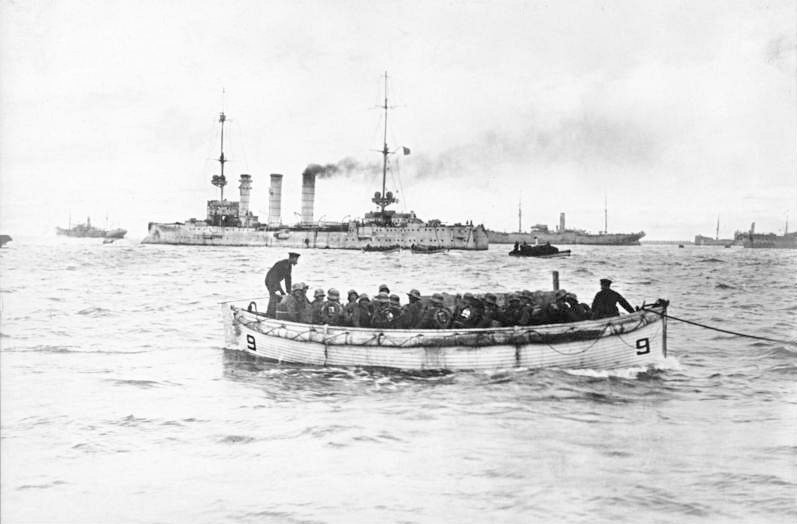
Troops landing at ösel island 1917
Operations of late 1916
On 18 August 1916, the Kaiser class took part in a sortie to shell Sunderland and Admiral Scheer repeated the 31 May plan, but with only the two remaining German battlecruisers, Moltke and Von der Tann, reinforced by three fast battleships. His goal was to draw out Vice Admiral David Beatty’s battlecruisers and seek a decisive engagement. Meanwhile as usual, the German battleships would trail behind to provide support. However Scheer received a message (which proved later false, from a zeppelin) about a British unit in the area and turned north. The shelling never took place, and the city was spared. By 14:35, Scheer received another message that the Grand Fleet was approaching, he therefore turned his forces around and retreated back to Germany.
Despite mixed results, Jutland forced a semi-inactivity of the German fleet. Losses with the battlecruisers and the preeminence of submarine warfare took their toll on the will to engage the forces in another decisive engagement. Nothing happened in 1916 but a short operation on 18–19 October, but without encounrting a single British ship. A large training exercize in the Baltic was conducted, in which the III Squadron covered a small fleet sent to recover of a pair of U-boats stranded on the Danish coast. On 1 December 1916 the fleet was completely reorganized and while the four König-class battleships still made the III Squadron but when SMS Bayern was commissonied, the König took their place tnad they were transferred to IV Squadron. Also, Friedrich der Grosse replaced Prinzregent Luitpold as flagship of IV Squadron.
Operations of 1917
Morale plummited both because of the inactivity, poor results after Jutland, relative disinterest from the Kaiser, poor rations, the population being stricken by the blocus while the fleet was ciritized. This coalesced into a series of small mutinies: On 6 June and 19 July 1917, stokers protested the poor food they were given. On 2 August 800 sailors went on a hunger strike, officers agreed to form a Menagekommission giving the crew a voice in their food composition and preparation while on the other hand, one of the ringleaders was arrested and executed on 5 September 1917.
Meawnile, the Kaiser class saw no major operations in the first half of 1917, and on 18 August she went into drydock at the Imperial Dockyard in Kiel for periodic maintenance lasting until 23 September. The other battleships of the class also went into drydock by that time.
Operation Albion Sept. 1917
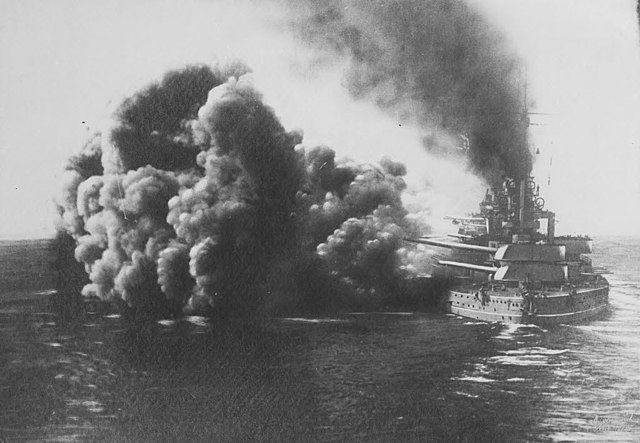
Prinzregent Luitpold bombarding Ösel, October 1917
In early September 1917, German forces captured the Russian port of Riga, and the German navy assisted to expel the Russian naval forces holding the Gulf of Riga. The Admiralstab (Navy High Command) wanted to launch an operation in the Moonsund archipelago, targeting Russian gun batteries on the Sworbe peninsula (Ösel); On 18 September, a joint Army-Navy operation to capture Ösel and Moon islands as launched. The Kaiser class was led by the flagship Moltke, III Battle Squadron with V Division (the four Königs) and the newly commissioned Bayern while VI Division comprised the five Kaiser-class. With nine light cruisers and three TBs flotillas plus dozens of minesweepers made a force of 300 ships, supported by more thaa 100 aircraft plus six zeppelins.
The invasion force itself amounted to around 24,600 officers and enlisted men. To face them, the Russians only had the pre-dreadnoughts Slava and Tsarevitch, reinforced by the armored cruisers Bayan, Admiral Makarov, and Diana; They were also bolstered by 26 destroyers and a few torpedo boats and gunboats. The infantry garrison on Ösel Island was limited to 14,000 men, including those manning the shore batteries.
The operation took place on 12 October and the Kaiser-class battleships rained shells on the Sworbe peninsula joined by the Moltke, Bayern, and König class ships which fired on the Russian shore batteries (Tagga Bay). Kaiser was detached on 14 October to deal with the Russian destroyers which harrassed the German minesweepers, soon covering a rush of German torpedo boats into the Sound. This cost the Russians the destroyer Grom.
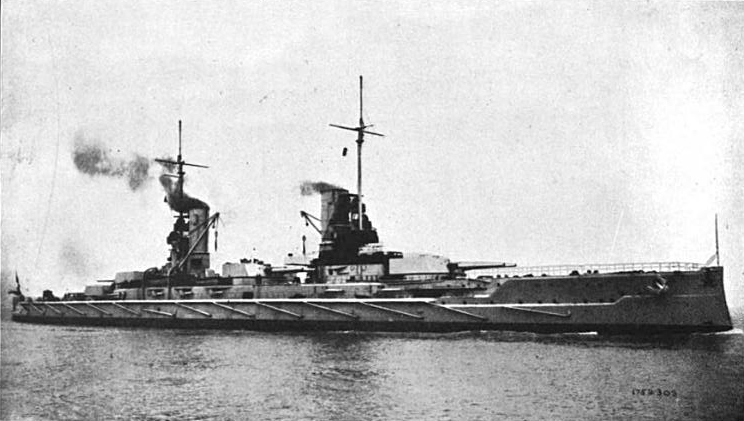
SMS Friedrich der Grosse on trials before the war
12-in batteries at Zerel were taken care of by Kaiserin, König Albert, and Friedrich der Grosse at ranges of between 7.5 and 12.5 miles. Russian counter-fire was efficient however, forcing German dreadnoughts to change course to avoid being hit. However the squadron commander eventually decided to withdrew by fear of remaining mines and Russian submarines. The next day at dawn, the two König-class entered Moon Sound and sank Slava, while the remaining warships fled and by 20 October, this was all over. This was the last action of the Kaiser class battleships.
Fate of the Kaiser class
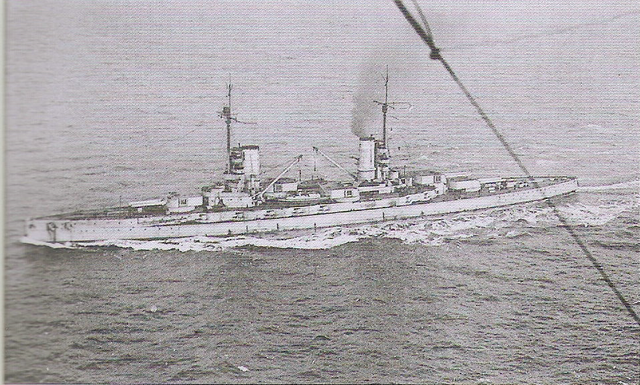
SMS Kaiser steaming to Scapa Flow
Germany capitulated in November 1918, and fate of the High Seas Fleet under the command of Rear Admiral Ludwig von Reuter, was uncertain. Before that, a last mission was planned; a grand style attack in the north sea to draw the Grand fleet into a climactic naval battle, to “save the honor” of the Hochseeflotte. But mutiny, now fuelled by bolshevik elements, became widespread, and as the fleet gathered for action, many sailors deserted. The operation was eventually recalled and the last trip of the German battle squadron would be indeed in the North sea, but right to the Grand fleet base, Scapa Flow, after long negotiations.
Indeed the armistice conditions decided the fleet should be interned in the Orcades, far away in the northern Scottish islands. The fleet departed on 25 November under heavy escort of British, US and other entente vessels, to remain in captivity during the peace negotiations in Paris. Ultimately this would led to the Versailles Treaty. It became apparent to Admiral Reuter that the British intended to seize the fleet on 21 June, the deadline to sign the peace treaty, as a pressure move. However Von reuter was unaware this deadline had been extended to the 23rd, and ordered his ships be sunk, which was fast as all preparations has been made. It was carried out on 21 June at dawn, when most of the Grand Fleet has left Scapa to conduct training maneuvers, and the scuttling started at 10:00 AM.
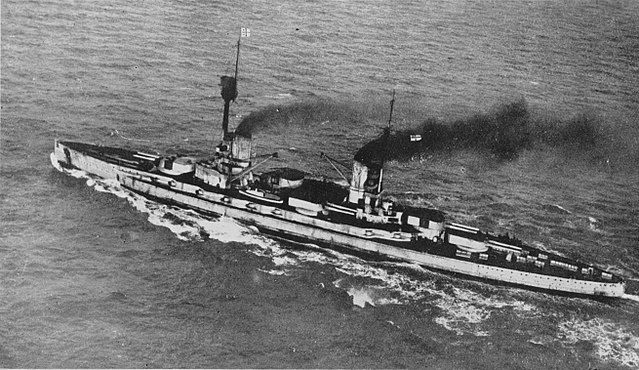
Friedrich der Grosse en rote to Scapa Flow
SMS Friedrich der Grosse was the first to be scuttled, sinking completely at 12:16. She would be raised on 29 April 1937, towed to Rosyth for scrapping, but her bell was returned to Germany in 1965. Now she is displayed at the Bundesmarine Headquarters in Glücksburg. SMS König Albert sank at 12:54, second to sink. She was raised on 31 July 1935. SMS Kaiser sank at 13:25, raised on 20 March 1929. SMS Prinzregent Luitpold sank at 13:30 and raised on 9 July 1931. SMS Kaiserin sank at 14:00, raised on 14 May 1936. An thus ended this page of German battleships construction for Germany, the largest battle fleet the country ever had in its history.
Author’s illustration of the Kaiser
Specifications
Displacement: 24 700 t – 27 000 t FL
Dimensions: 172,4 x 29 x 9,1 m (565 ft 7 in, 95 ft 2 in, 29 ft 10 in))
Propulsion: 3 shaft Parsons turbines*, 16 Schulz-Thornycroft boilers, 31 000 hp and 21 knots.
Range: 7,900 nmi (14,600 km; 9,100 mi) at 12 knots (22 km/h; 14 mph)
Armour protection: Belt 350, Batterie 170, Citadel 210, Turrets 300, Blockhaus 350, barbettes 300 mm
Crew: 1084
Armament: 10 x 305 (6×2), 14 x 150, 8 x 88 mm DP, 5 x 500 mm TTs.
Main Src:
https://en.wikipedia.org/wiki/Kaiser-class_battleship
https://commons.wikimedia.org/wiki/Category:Kaiser_class_battleship?uselang=de
http://www.fr.naval-encyclopedia.com/1ere-guerre-mondiale/Kaiserliche-Marine.php#crois
Conway’s all the world fighting ships 1906-1921
Campbell, N. J. M. (1977). Preston, Antony (ed.). “German Dreadnoughts and Their Protection”. Conway
Dodson, Aidan (2016). The Kaiser’s Battlefleet: German Capital Ships 1871–1918. Seaforth Publishing.
Breyer, Siegfried; Kurti, Alfred (1973). Battleships and Battle Cruisers 1905–1970: Historical Development of the Capital Ship [Schlachtschiffe und Schlachtkreuzer 1905–1970].
Grießmer, Axel (1999). Die Linienschiffe der Kaiserlichen Marine: 1906–1918; Konstruktionen zwischen Rüstungskonkurrenz und Flottengesetz
Gröner, Erich; Jung, Dieter; Martin, Maass (1990). German Warships: 1815–1945. Vol. I: Major Surface Vessels.
Nottlemann, Dirk (2017). “From Ironclads to Dreadnoughts: The Development of the German Navy 1864–1918, Part VIII: “Consolidation or Continuous Crisis?””. Warship International. International Naval Research Organization.
Preston, Anthony (1972). Battleships of World War I: An Illustrated Encyclopedia of the Battleships of all Nations, 1914–1918.
Staff, Gary (1995). Battle for the Baltic Islands 1917. Pen & Sword Maritime.
Tarrant, V. E. (2001) [1995]. Jutland: The German Perspective.
Weir, Gary E. (1992). Building the Kaiser’s Navy: The Imperial Navy Office and German Industry in the Tirpitz Era, 1890–1919.


 Latest Facebook Entry -
Latest Facebook Entry -  X(Tweeter) Naval Encyclopedia's deck archive
X(Tweeter) Naval Encyclopedia's deck archive Instagram (@navalencyc)
Instagram (@navalencyc)





 French Navy
French Navy Royal Navy
Royal Navy Russian Navy
Russian Navy Armada Espanola
Armada Espanola Austrian Navy
Austrian Navy K.u.K. Kriegsmarine
K.u.K. Kriegsmarine Dansk Marine
Dansk Marine Nautiko Hellenon
Nautiko Hellenon Koninklije Marine 1870
Koninklije Marine 1870 Marinha do Brasil
Marinha do Brasil Osmanlı Donanması
Osmanlı Donanması Marina Do Peru
Marina Do Peru Marinha do Portugal
Marinha do Portugal Regia Marina 1870
Regia Marina 1870 Nihhon Kaigun 1870
Nihhon Kaigun 1870 Preußische Marine 1870
Preußische Marine 1870 Russkiy Flot 1870
Russkiy Flot 1870 Svenska marinen
Svenska marinen Søværnet
Søværnet Union Navy
Union Navy Confederate Navy
Confederate Navy Armada de Argentina
Armada de Argentina Imperial Chinese Navy
Imperial Chinese Navy Marinha do Portugal
Marinha do Portugal Mexico
Mexico Kaiserliche Marine
Kaiserliche Marine 1898 US Navy
1898 US Navy Sovietskiy Flot
Sovietskiy Flot Royal Canadian Navy
Royal Canadian Navy Royal Australian Navy
Royal Australian Navy RNZN Fleet
RNZN Fleet Chinese Navy 1937
Chinese Navy 1937 Kriegsmarine
Kriegsmarine Chilean Navy
Chilean Navy Danish Navy
Danish Navy Finnish Navy
Finnish Navy Hellenic Navy
Hellenic Navy Polish Navy
Polish Navy Romanian Navy
Romanian Navy Turkish Navy
Turkish Navy Royal Yugoslav Navy
Royal Yugoslav Navy Royal Thai Navy
Royal Thai Navy Minor Navies
Minor Navies Albania
Albania Austria
Austria Belgium
Belgium Columbia
Columbia Costa Rica
Costa Rica Cuba
Cuba Czechoslovakia
Czechoslovakia Dominican Republic
Dominican Republic Haiti
Haiti Hungary
Hungary Honduras
Honduras Estonia
Estonia Iceland
Iceland Eire
Eire Equador
Equador Iran
Iran Iraq
Iraq Latvia
Latvia Liberia
Liberia Lithuania
Lithuania Mandchukuo
Mandchukuo Morocco
Morocco Nicaragua
Nicaragua Persia
Persia San Salvador
San Salvador Sarawak
Sarawak Uruguay
Uruguay Venezuela
Venezuela Zanzibar
Zanzibar Warsaw Pact Navies
Warsaw Pact Navies Bulgaria
Bulgaria Hungary
Hungary

 Bundesmarine
Bundesmarine Dutch Navy
Dutch Navy Hellenic Navy
Hellenic Navy Marina Militare
Marina Militare Yugoslav Navy
Yugoslav Navy Chinese Navy
Chinese Navy Indian Navy
Indian Navy Indonesian Navy
Indonesian Navy JMSDF
JMSDF North Korean Navy
North Korean Navy Pakistani Navy
Pakistani Navy Philippines Navy
Philippines Navy ROKN
ROKN Rep. of Singapore Navy
Rep. of Singapore Navy Taiwanese Navy
Taiwanese Navy IDF Navy
IDF Navy Saudi Navy
Saudi Navy Royal New Zealand Navy
Royal New Zealand Navy Egyptian Navy
Egyptian Navy South African Navy
South African Navy






























 Ukrainian Navy
Ukrainian Navy dbodesign
dbodesign
13.5 inch not 14 inch for British. Bayern class was to have !5 inch not 16 inch gun. keep consistency, most articles use long tons everywhere, this one uses metric tons in story line. Another article says Panama canal when it means Kiel canal. get a proof reader for goodness sake